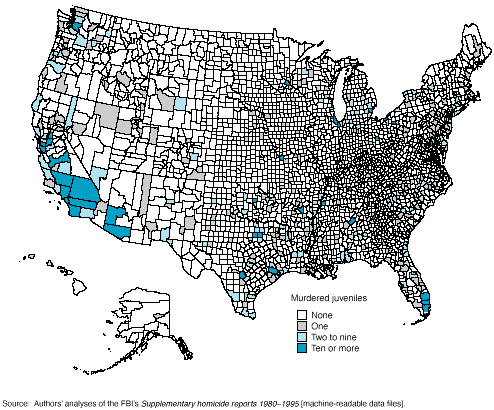|
In 1995 the Nation's estimated 2,300 known juvenile murderers were geographically concentrated  Each year the FBI collects from a large sample of law enforcement agencies across the Nation a detailed report on each homicide that occurred in their jurisdictions. In 1995 the FBI estimates that these Supplementary Homicide Reports (SHR) were submitted on 93% of all homicides in the Nation. The SHR file was analyzed, excluding all negligent manslaughters and justifiable homicides, to produce a count of known offenders under the age of 18 in each U.S. county in 1995. A small number of counties with no reported juvenile murderers in 1995 were counties that reported incomplete or no data; most were counties that actually had no juvenile homicide offenders. In 38% of murder incidents, offender characteristics were unknown, mostly because no offender was ever identified. These data limitations result in two sources of undercounts of juvenile murderers in the above map: a slight undercount of known juvenile offenders (given that 7% of homicides were not reported to the FBI) and a greater undercount of actual juvenile homicide offenders, given that a significant portion (38%) of reported murders were never solved or their solutions never reported to the FBI. With these limitations in mind, the SHR data show that 84% of the 3,139 counties in the United States reported no juvenile homicide offenders in 1995. Another 10% reported only one juvenile homicide offender. In contrast, 25% of all known juvenile homicide offenders were reported in just five counties. These were the counties that contain the following cities: Los Angeles, Chicago, Houston, Detroit, and New York City. Homicides by juveniles peaked in 1994 -- in 1995 firearm homicides by black males declined
2,300 juveniles were implicated in 1,900 murders in 1995 The FBI estimates 21,600 persons were murdered in the U.S. in 1995. According to the FBI's Supplementary Homicide Report data, law enforcement agencies were able to identify the offender in two-thirds (62% or about 13,400) of these crimes. In the remaining homicides (38% or about 8,200), no offender was identified. The proportion of homicides in which an offender was not identified has grown from about 30% in the early 1980's, with the levels being relatively constant from 1992 through 1995. A juvenile was an offender in 14% (or about 1,900) of all homicides for which an offender was identified in 1995 -- with 2,300 juvenile offenders implicated in these 1,900 homicides. In nearly one-third (32%) of these juvenile-involved homicides, an adult offender was also implicated. Who did juveniles kill in 1995? Most victims were male (85%). Slightly more were black (49%) than white (48%). About 3 in 10 victims were below age 18.
Seventy-nine percent of the victims of juvenile homicide offenders were killed with a firearm. Ten percent of victims were family members, 54% were acquaintances, and 36% were strangers.
Homicides by juveniles increased from 1984 to 1994 In 1980 juveniles were known to be an offender in 8% of all homicides for which an offender was identified (or about 1,300). These numbers declined through 1984 when there were about 800 homicides in which a juvenile offender was involved, or 5% of all homicides. After 1984 homicides by juveniles grew both in number and in proportion to the whole. The levels peaked in 1994 when juveniles were implicated in 16% of all homicides (or about 2,300). What happened in 1995? After more than a decade of increases, homicides by juveniles dropped substantially (17%) in 1995. A comparison of juvenile-involved murders in 1994 to those in 1995 indicates the nature of this decline. The decline was found in all age groups of offenders. Declines were observed in both homicides with lone offenders and in homicides committed by more than one person. The decline was observed in homicides by male juveniles, while homicides by female juveniles remained constant. Nearly all of the decline was in homicides by black juveniles. Between 1994 and 1995, while homicides of family members remained constant, declines were found in homicides of acquaintances and strangers. Finally, compared with 1994, all of the decline in homicides by juveniles in 1995 were firearm-related homicides. Therefore, compared with 1994, 1995 saw a reduction in homicides by black male juveniles of non-family members in which the weapon used was a firearm. |
| Previous | Contents | Next |
|
Juvenile Offenders and Victims: 1997 Update on Violence |